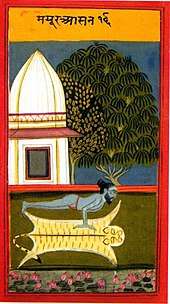Ṭiṭṭibhāsana
Tittibhasana (Sanskrit: टिट्टिभासन Ṭiṭṭibhāsana) or Firefly pose is an arm-balancing asana in hatha yoga and modern yoga as exercise.[1]

Etymology and origins
The name of this pose comes from Sanskrit: Ṭiṭṭibha, "small insect, firefly", and āsana, "posture" or "seat".[2]
An alternative etymology is from the story of a pair of Tittibha birds that nested by the sea; the ocean swept away their eggs, and the birds complained to Vishnu, asking for the eggs to be returned. The god gave the order, and the sea gave the eggs back. The effectiveness of the small weak birds is said to be used as a symbol of yoga, able to overcome the power of illusion in the world.[3]
The pose is described and illustrated in the 19th century Sritattvanidhi as Mālāsana, garland pose; that name is given to a different asana in Light on Yoga.[4]
Description
Tittibhasana is described in Light on Yoga as being entered from Dvi Pada Sirsasana, a difficult sitting pose with the legs crossed behind the head, that in B. K. S. Iyengar's words "requires practice", by uncrossing the ankles, stretching the legs straight up, and pushing down on the hands to balance.[5]
The pose is said to activate the manipura chakra at the solar plexus.[6]
See also
- Bhujapidasana, another arm-balancing pose with the legs in front of the body
References
- Sell, Christina. "A Challenging Balance Pose: Tittibhasana (Firefly Pose)". Yoga International. Retrieved 20 January 2019.
- "Firefly Pose - Tittibhasana - Yoga Pose". 28 August 2007.
- "Tittibhasana [A]". Ashtanga Yoga. Retrieved 20 January 2019.
- Sjoman 1999, p. 72.
- Iyengar 1979, pp. 308-309.
- "Tittibhasana". Yogapedia. Retrieved 20 January 2019.
Sources
- Iyengar, B. K. S. (1979) [1966]. Light on Yoga: Yoga Dipika. Unwin Paperbacks. ISBN 978-1855381667.CS1 maint: ref=harv (link)
- Sjoman, Norman E. (1999). The Yoga Tradition of the Mysore Palace. Abhinav Publications. ISBN 81-7017-389-2.CS1 maint: ref=harv (link)
_from_Jogapradipika_1830_(detail).jpg)

